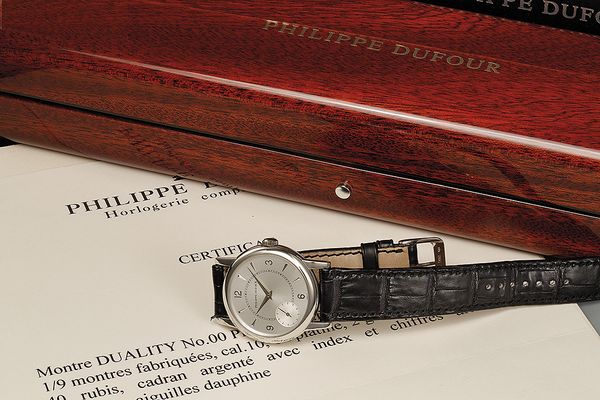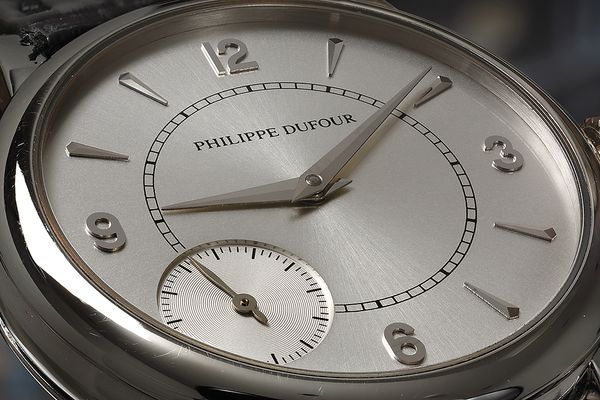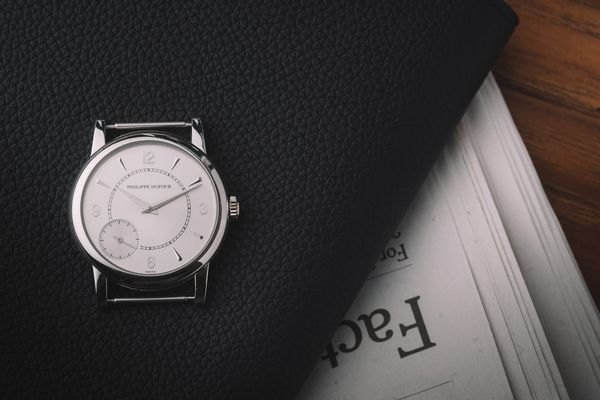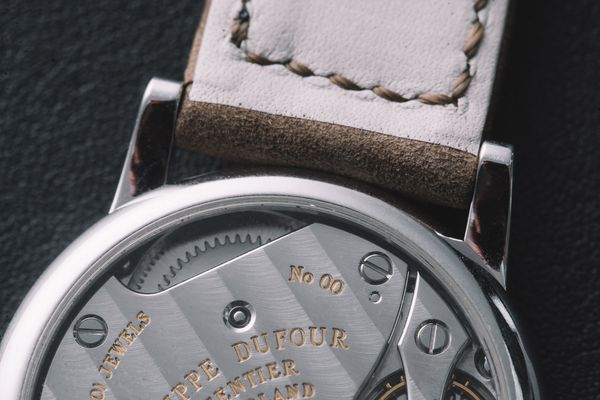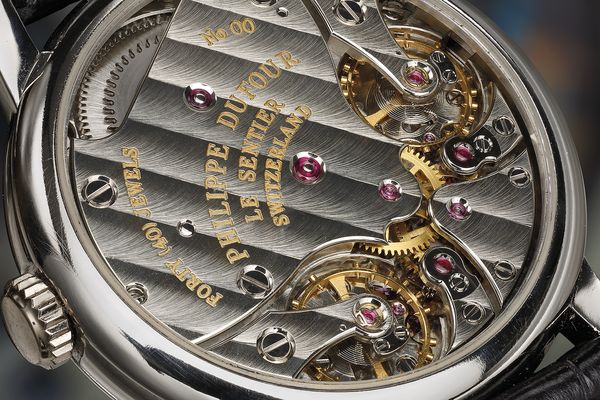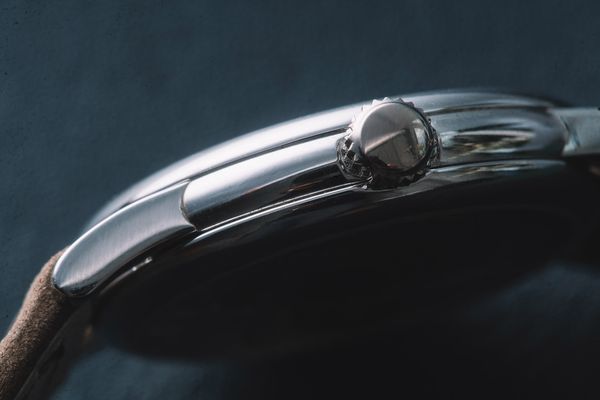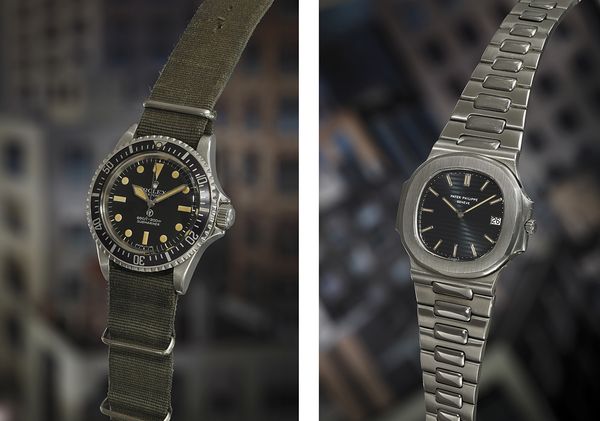Philippe Dufour Duality, 1996. An exceedingly rare, important, and early platinum wristwatch with double regulator, certificate and fitted presentation box.
It's difficult to say what's more complicated. Getting a watch directly from Philippe Dufour's atelier, or getting it through the auction room. Take the Duality. Only nine were made, but only one has ever been offered at auction. It happens to be the most important in the series, by pedigree, and this is the second time it will be sold at auction, ten years after the first.
The estimate for it back then? Between CHF 25,000 and CHF 35,000. The auction house that evening had made the same projection for the watch that preceded the Duality in the sale, a limited edition Royal Offshore made in titanium. The Duality did considerably better on the night, hammering in for CHF 180,000.
The Duality was the last great innovation of the 20th century.
Now it’s back and its improbable return to the auction room is one of the most exciting events of the year for a few reasons.
The Duality was the last great innovation of the 20th century. Made in 1996, it was the very first dual escapement wristwatch, and the most compact version of a complex mechanism which had troubled watchmakers during two centuries before.
Dufour was born in 1948, in Le Sentier, a village in the Vallée de Joux. Like many boys who grew up in the region, he decided to pursue watchmaking and enrolled in the local technical school before joining Jaeger-LeCoultre, the town's main employer. Dufour set up his own brand in 1987 after spending a couple of years restoring pieces. His first movement was nothing less than a Grande Sonnerie, which he pitched to Audemars Piguet. The manufacturer ordered five and cased them in pocket watches that would eventually bear its name.
Two and a half years later, Dufour unveiled a more compact version, officially the world's first Grande Sonnerie wristwatch. This time, it was his name on the dial, and the watch launched his career when it was presented at Baselworld. It was soon followed by another important feat in miniaturization.
Having proven himself a master of high-complications, Dufour's next move was to focus on precision horology. Double regulator watches presented an interesting challenge. The idea that a watch could achieve better timekeeping by averaging down the rate differentials between two independently operating balances had been explored. But only very large examples had ever been made because of the complexity of their mechanism. The Vallée de Joux had produced the most successful attempt when, in the 1930s, students of the school Dufour later attended made a small batch of double regulator pocket watches.
...It set the tone as far as what a Dufour wristwatch should look like: understated, traditional and impossible to fault.
The Duality was originally planned as a series of 25 watches, but Dufour ended it prematurely because of the popularity of another of the atelier's watches, the Simplicity. Dufour felt he couldn't split his time equally to both projects and put the Duality on pause after only nine models.
The present watch is N°00, the first in the series, and it set the tone as far as what a Dufour wristwatch should look like: understated, traditional and impossible to fault.
The brilliance of Dufour's work is that every component is conceived by one person, with intimate knowledge of its final position on the dial in relation to other elements. The markers and hands for example, are cut from the same metal, and finished using the same time-honored techniques.
The minute track is simple but it occupies a central position which allows for a clear read of the time. Some tension is created by the intersection of a seconds sub-dial at eight o'clock, distinguished by a circular grain finish, but there is also a hint that the movement's architecture is atypical.
Philippe Dufour's movements are among the finest in the world. Not only is the symmetrical construction of the movement naturally pleasing to the eye, but the movement is then finished using an array of decorative techniques, including Geneva stripping, chamfering, black polishing and hand-engraving.
The Duality is not a watch that immediately stands out in a line-up of vintage watches. We've seen it this month during the Winning Icons auction previews across Asia, the United Kingdom and the United States, currently in New York where it will ultimately be auctioned. If someone didn't know anything about the Duality, they'd probably skip right over it to see the first series Patek Philippe Nautilus or the Rolex Milsub standing either side of it.
Left: Rolex Ref. 5513, 'Milsub' or 'Military Submariner', 1974; Right: Patek Philippe Ref. 3700/001, Nautilus 'Jumbo', 1977
But the Duality has its fans, and to them, this is clearly the most important watch in our sale. Because it represents the resurgence of independent watchmaking, because it represents the resurgence of traditional Swiss watchmaking, and most of all, because they know that no one will ever make a watch quite like it again.
Dufour never returned to the bench for the Duality. The owners' club became unexpectedly exclusive after the ninth model was delivered and that makes its membership even more desirable.
The return of N°00, therefore, represents an unexpected opportunity for collectors who thought they had missed out at the chance of owning this model one day. The watch will be offered in complete condition, accompanied by its original certificate, brochure, and fitted presentation box.
